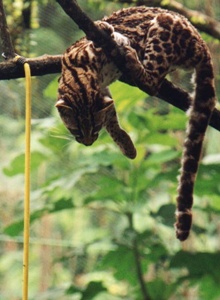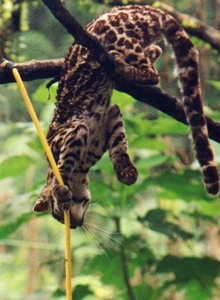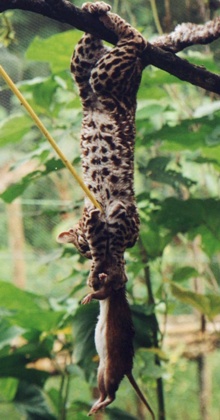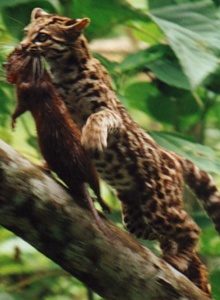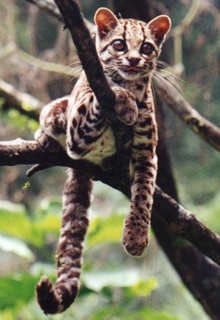WILD
WE
by
Rosa Jordan
Women's
Voices,
April 2002
We aren't alike, Jona and I. She is artistic, spiritual, and
scientific. I am literary, athletic, and political. We were together
that year in Mexico only because we were what we were: mother and
daughter, both impatient for independence. We had scarcely arrived as
women, I recently escaped from an oppressive marriage, Jona just
reaching her fifteenth birthday. We had no idea where our womanhoods,
once emerged, would take us, how our then-entwined lives would separate
and, decades later, braid together again. Nor did we know that the
third strand of the braid would be our shared passion for one small
exotic animal of a species we had never known existed.
Testing Jona's independence and mine, I traveled to the Yucatan,
leaving her in San Miguel de Allende, studying art and Spanish. I
returned with a baby wildcat, bought with snorkeling equipment and all
my tears, from the hunter who had killed its mother. I handed the ball
of spitting fluff to my daughter and, to tease and horrify her, said it
was the "fur coat" which every "lady" should have.
What was this black-and-gold creature, too tiny to be a jaguar or even
an ocelot? It was, we later learned, something even rarer: a margay.
Margays are nocturnal and live in the rainforest canopy. They are
capable of extraordinary acrobatic feats; with their reversible feet,
can climb headfirst down vertical surfaces (trees, screen doors,
drapes). This one lived in the canopy of our home for a year, moving in
great leaps from shelves to table tops to refrigerator to the tops of
open doors. It could open doors, too; hanging on the knob and swinging
its body until the door cracked open to let it into wherever it wanted
to go.
And then she was gone, our magical wild creature, running free,
running, dead. Killed by a passing car. My daughter went her way then,
and I mine. Life took her to university, to Africa, and into a career
as veterinarian which, if not selected, was at least suggested by the
little margay.
I also responded to the margay's silent call. I became a writer with a
penchant for traveling in tropical countries. It was in those
countries, seeing too many margays in cruel cell-like cages, too many
margay pelts pinned on walls, that I understood how this exquisitely
beautiful creature had become yet another endangered species. It didn't
matter how deep in the rainforest they lived. The truth was - is - that
for wild things, there are hardly any safe places left.
For decades Jona and I did not discuss this slaughter, because, it
seemed, there was nothing we could do about it. Didn't one have to be
Greenpeace or a millionaire to make a difference? Ah, but what if? If
only we could create a rainforest sanctuary for margays!
We called our dream "Touch the Jungle." It started as a fantasy. It
became a trip. Then more trips: Guyana, Guatemala, Belize, Mexico,
Brazil, and finally, Ecuador. To a remote rainforest community which
needed us as much as we needed it. Fifty-two families, descended from
slaves brought there 500 years ago to pan for gold. They killed their
slavemaster and remained, living free as hunter-gatherers, protected by
their isolation until the 1990s when, downriver, one could hear
chainsaws, and the sound of forests falling.
The community managed to get title to 25,000 acres of ancestral
forests. But a forest which once extended all the way to the Pacific
now only went to their boundary. How could they go on living off the
land?
Maybe it was the Jaguar God who piloted our dugout canoe up Rio
Santiago. With our uncertain Spanish and outrageous idea, what else
could have caused the people of Playa de Oro to trust us? With their
dark hunter-gatherer eyes and ancient fear of tigres y leons
(jaguars and pumas), how did we know they could be trusted?
We proposed a reserve. They took a year to think about it, and decided,
yes. Their 25,000 acres of rainforest would become the Playa de Oro
Reserva de Tigrillos, a sanctuary for all species of indigenous
wildcats: jaguars, pumas, ocelots, margays, oncillas, and jaguarundi.
The margay, which they call tigrillo (little tiger) is the reserve's
flagship species.
Mostly it's about habitat protection, a safe place where exotic
wildcats can live in peace, find mates, and replenish their dwindling
numbers. But it's also about a community that has shared the jungle
with them these centuries past, about native hunters willing to leave
off killing cats and other endangered species to ensure protection of a
rainforest and river which they need as much as the wild things do.
Do-it-yourself-conservation-on-a-shoestring isn't easy or quick. It
took us ten years to find a place, and five more to get it established,
with a lodge for visitors whose eco-dollars will sustain the sanctuary
and make it, someday, self-sufficient. The dream lives. Now our work is
gathering funds to keep it alive. It's also visiting the reserve,
seeing margay tracks around the lodge, and hearing their cries outside
our window at night. It's learning to love the villagers who look after
our little cats (their little cats) for wages of a mere $4 a day.
It's about encouraging people to do more than give money; to give
themselves the gift of time to go there. Call it proselytizing, call it
passion, call it a love of wildness. We call it connection, for that is
what it is: the interconnectedness of our margay memories, of our
mother/daughter selves, of ourselves with the rainforest, and with a
people we never knew existed, who are now as connected to us and the
exquisite little margays as we are to them.
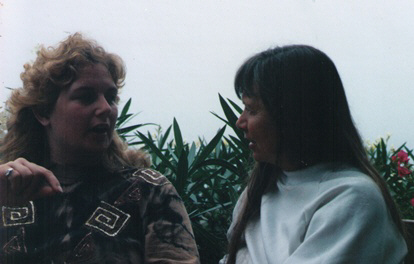 |
Jona
and Rosa
Photo
by Barbara Nelson
|
